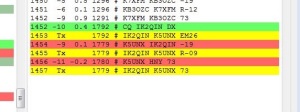 JT65 – A new mode for me!
JT65 – A new mode for me!
A few weeks ago, I decided to try JT65. I had been working a small amount of phone this year, along with a little PSK31. I liked PSK31 because I could watch a football game and work the quiet digital mode at the same time. I was curious about JT65 a few weeks ago, so I downloaded some software and decided to give it a try.
I’ll leave out all the history of the mode as it’s easy to find on the net. Basically it’s a digital mode, that’s great for low power operation. Originally developed for EME (Earth-Moon-Earth, Moon bounce) application, it’s very common to use 5-10 watts making contacts all over the world, depending on the condition of the bands. Information is sent over and over again to provide redundancy
JT65 is not a mode that anyone os going to rag chew on. The messages that are exchanged are very scripted and only 13 characters in length. I wondered for a while what practical use a series of 13 character messages would be, outside of making contacts simply for earning awards. I suppose you could use it when a short message has to absolutely get through. The software will repeat the message over and over again until you tell it to stop.
While there are a few software packages available for JT65, I chose to use WSJT-X. Another popular program that’s available is JT65-HF. WSJT-X will do both JT65 and JT9 but JT65-HF will only do JT65. I am finding that making JT9 contacts, works just like JT65, though the underlying protocols being sent over the air are different. JT9 uses much less bandwidth, and signals can be much closer together than JT65.
Messages are transmitted on alternating minutes. One station might call CQ. That message is sent for 46.8 seconds. There is a 13.2 second decoding period. The reply transmission is sent starting at the beginning of the next minute for the same 46.8 seconds. Again there is a 13.2 second decoding period and it all starts over again. One station ends up transmitting on the odd minutes, while the other station transmits on the even minutes. A normal JT65 QSO will last 7 minutes. The CQ station sends four messages while the station answering the CQ will send 3. Some stations that call CQ cut out of the messages making for a total of three sent for each station.
The following is an actual QSO that I had with a station in Italy, using 10 watts and a homemade buddipole.
The Italian station called CQ and I answered at 1453 UTC time. The entire QSO was over after both of us sent 73 messages! This is what almost all QSO’s are like.
Since I started JT65 in the middle of December, I have made 108 JT65 QSO’s and 19 JT9 QSO’s. I am slowly working on my basic WAS, trying to get most of the rest with JT65 or JT9. As of Dec 26, I only need 3 more states and I am determined to do it with JT65!
The following are some learning experiences and things I would pass on to anyone interested in trying JT65 for the first time.
While there might be other software packages, JT65-HF an WSJT-X seem to the be the two most popular, based on my reading on the Net and forum posts on eham.net and qrz.com. I would suggest downloading both and giving them a trial run before deciding. Regardless of which one you choose, I would highly suggest adding JTAlert. It’s a program that works with WSJT-X or JT65-HF alerting you to things like DXCC entities you need, states needed or WAS, stations you have worked before and many other things. I think it makes the mode more fun.
While PSK31 is a SSB mode, JT65 is not. It is an AFSK mode so you have to make sure you set your radio appropriately. Some articles don’t seem to mention this so some beginners miss this point. It does use USB like PSK31, but the modulation is different and the radio needs to be set properly.
I also ran into a configuration issue when setting up my Signalink USB for JT65. While working stations, I occasionally ran into an issue where the radio would key up and transmit, but nothing was sent out. No power on the power meter, nothing. I had set up the software to control my radio via CAT control. I found, after a lot of research, that my software was sending a PTT to the radio as was the Signaling USB. I suspect that when the software PTT got there first, that’s when the issue would happen. I set the software to VOX, letting the Signalink send the PTT and everything has been fine ever since. http://www.hamspot.org was a helpful resource to see if I was getting a signal out.
In the end, I am finding JT65 very enjoyable. It’s quiet so it does not bother my wonderful XYL. I can also do other things and not give the radio 100% attention. With JTAlert, it will tell me when someone is calling CQ or a needed state or country poops up. If you have not tried JT65 out, give it a shot and you might find fun.














